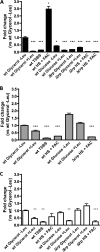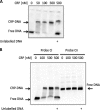The TonB3 system in the human pathogen Vibrio vulnificus is under the control of the global regulators Lrp and cyclic AMP receptor protein
- PMID: 22307757
- PMCID: PMC3318495
- DOI: 10.1128/JB.06614-11
The TonB3 system in the human pathogen Vibrio vulnificus is under the control of the global regulators Lrp and cyclic AMP receptor protein
Abstract
TonB systems transduce the proton motive force of the cytoplasmic membrane to energize substrate transport through a specific TonB-dependent transporter across the outer membrane. Vibrio vulnificus, an opportunistic marine pathogen that can cause a fatal septicemic disease in humans and eels, possesses three TonB systems. While the TonB1 and TonB2 systems are iron regulated, the TonB3 system is induced when the bacterium grows in human serum. In this work we have determined the essential roles of the leucine-responsive protein (Lrp) and cyclic AMP (cAMP) receptor protein (CRP) in the transcriptional activation of this system. Whereas Lrp shows at least four very distinctive DNA binding regions spread out from position -59 to -509, cAMP-CRP binds exclusively in a region centered at position -122.5 from the start point of the transcription. Our results suggest that both proteins bind simultaneously to the region closer to the RNA polymerase binding site. Importantly, we report that the TonB3 system is induced not only by serum but also during growth in minimal medium with glycerol as the sole carbon source and low concentrations of Casamino Acids. In addition to catabolite repression by glucose, l-leucine acts by inhibiting the binding of Lrp to the promoter region, hence preventing transcription of the TonB3 operon. Thus, this TonB system is under the direct control of two global regulators that can integrate different environmental signals (i.e., glucose starvation and the transition between "feast" and "famine"). These results shed light on new mechanisms of regulation for a TonB system that could be widespread in other organisms.
Figures











Similar articles
-
All Three TonB Systems Are Required for Vibrio vulnificus CMCP6 Tissue Invasiveness by Controlling Flagellum Expression.Infect Immun. 2015 Nov 2;84(1):254-65. doi: 10.1128/IAI.00821-15. Print 2016 Jan. Infect Immun. 2015. PMID: 26527216 Free PMC article.
-
A MARTX Toxin rtxA Gene Is Controlled by Host Environmental Signals through a CRP-Coordinated Regulatory Network in Vibrio vulnificus.mBio. 2020 Jul 28;11(4):e00723-20. doi: 10.1128/mBio.00723-20. mBio. 2020. PMID: 32723914 Free PMC article.
-
The ttpC gene is contained in two of three TonB systems in the human pathogen Vibrio vulnificus, but only one is active in iron transport and virulence.J Bacteriol. 2012 Jun;194(12):3250-9. doi: 10.1128/JB.00155-12. Epub 2012 Apr 13. J Bacteriol. 2012. PMID: 22505675 Free PMC article.
-
The TonB energy transduction systems in Vibrio species.Future Microbiol. 2010 Sep;5(9):1403-12. doi: 10.2217/fmb.10.90. Future Microbiol. 2010. PMID: 20860484 Free PMC article. Review.
-
Regulatory and pathogenesis roles of Mycobacterium Lrp/AsnC family transcriptional factors.J Cell Biochem. 2011 Oct;112(10):2655-62. doi: 10.1002/jcb.23193. J Cell Biochem. 2011. PMID: 21608015 Review.
Cited by
-
Two novel proteins, TtpB2 and TtpD2, are essential for iron transport in the TonB2 system of Vibrio vulnificus.Microbiologyopen. 2020 Jan;9(1):e00947. doi: 10.1002/mbo3.947. Epub 2019 Oct 8. Microbiologyopen. 2020. PMID: 31595707 Free PMC article.
-
Evolution of a global regulator: Lrp in four orders of γ-Proteobacteria.BMC Evol Biol. 2016 May 20;16(1):111. doi: 10.1186/s12862-016-0685-1. BMC Evol Biol. 2016. PMID: 27206730 Free PMC article.
-
The role of Vibrio vulnificus virulence factors and regulators in its infection-induced sepsis.Folia Microbiol (Praha). 2020 Apr;65(2):265-274. doi: 10.1007/s12223-019-00763-7. Epub 2019 Dec 16. Folia Microbiol (Praha). 2020. PMID: 31840198 Review.
-
All Three TonB Systems Are Required for Vibrio vulnificus CMCP6 Tissue Invasiveness by Controlling Flagellum Expression.Infect Immun. 2015 Nov 2;84(1):254-65. doi: 10.1128/IAI.00821-15. Print 2016 Jan. Infect Immun. 2015. PMID: 26527216 Free PMC article.
-
A Requirement for Global Transcription Factor Lrp in Licensing Replication of Vibrio cholerae Chromosome 2.Front Microbiol. 2018 Sep 10;9:2103. doi: 10.3389/fmicb.2018.02103. eCollection 2018. Front Microbiol. 2018. PMID: 30250457 Free PMC article.
References
-
- Brennt CE, Wright AC, Dutta SK, Morris JGJ. 1991. Growth of Vibrio vulnificus in serum from alcoholics: association with high transferrin iron saturation. J. Infect. Dis. 164: 1030– 1032 - PubMed
-
- Browning DF, et al. 2004. Modulation of CRP-dependent transcription at the Escherichia coli acsP2 promoter by nucleoprotein complexes: anti-activation by the nucleoid proteins FIS and IHF. Mol. Microbiol. 51: 241– 254 - PubMed
-
- Browning DF, Busby SJ. 2004. The regulation of bacterial transcription initiation. Nat. Rev. Microbiol. 2: 57– 65 - PubMed
Publication types
MeSH terms
Substances
Grants and funding
LinkOut - more resources
Full Text Sources
Molecular Biology Databases
Research Materials
Miscellaneous

